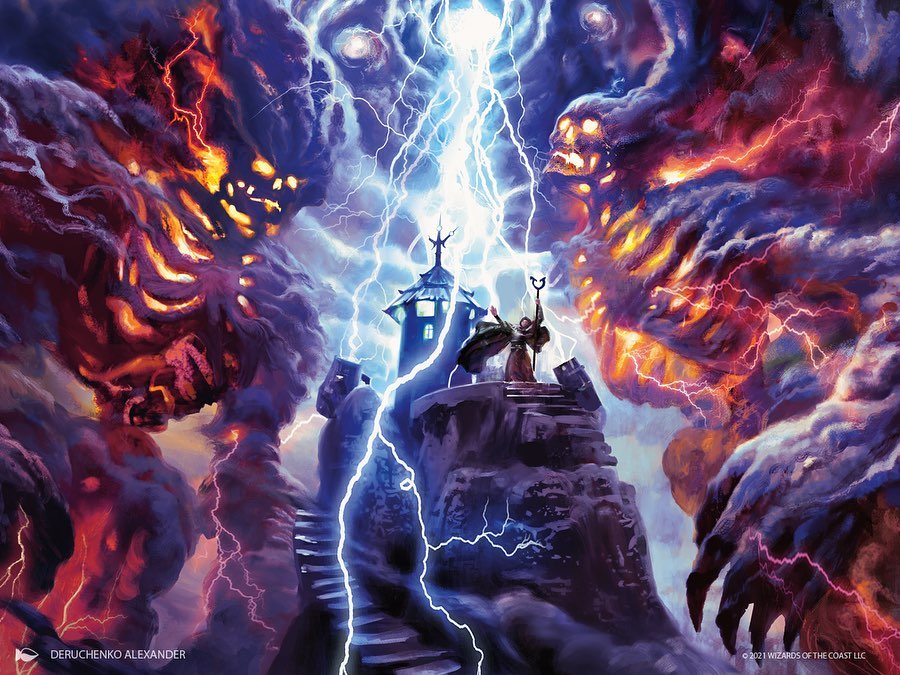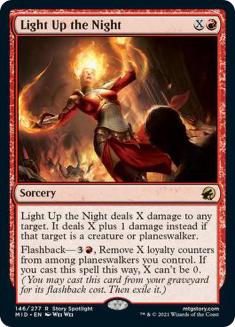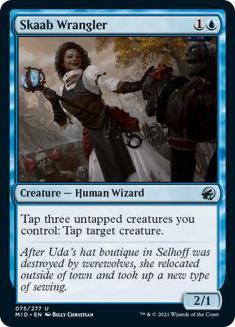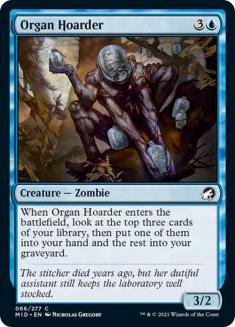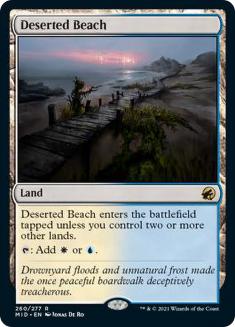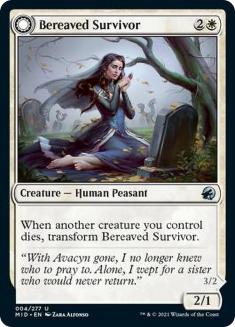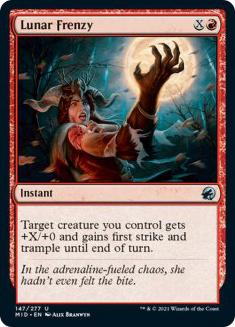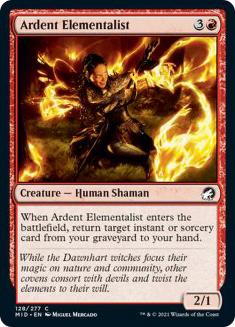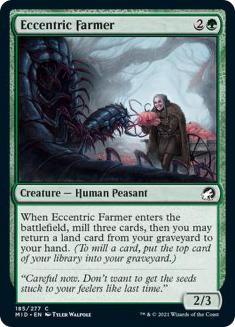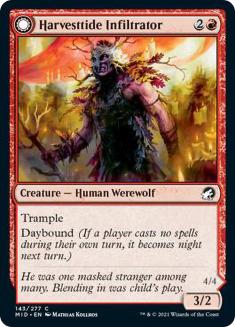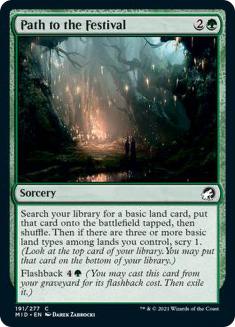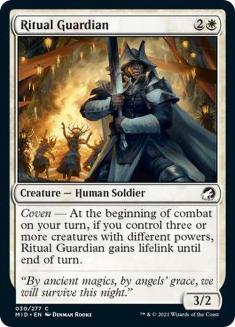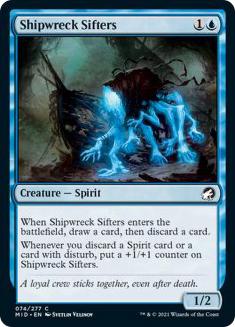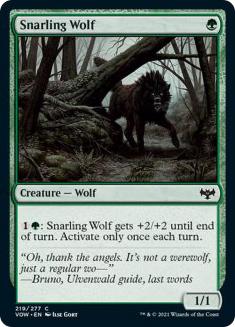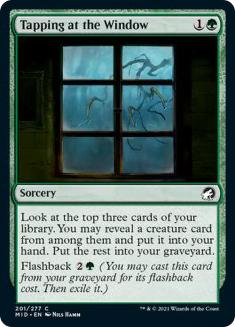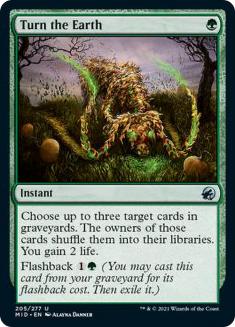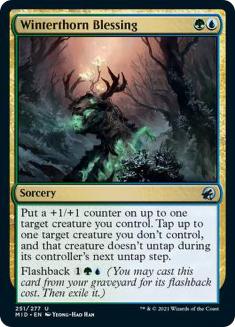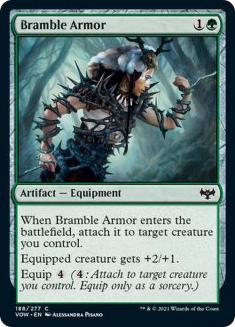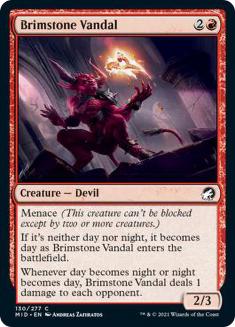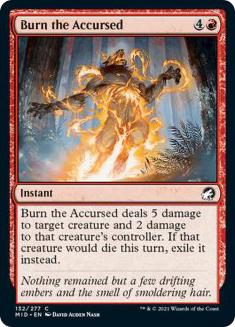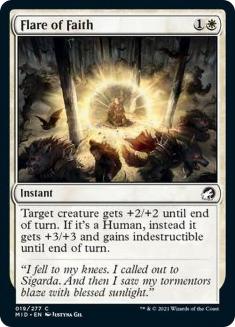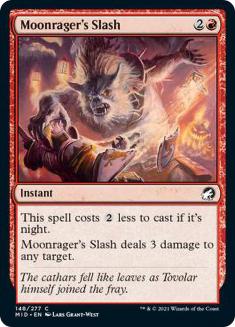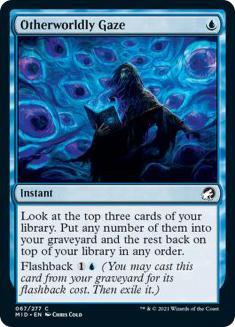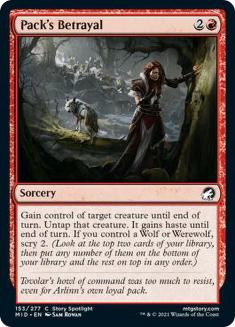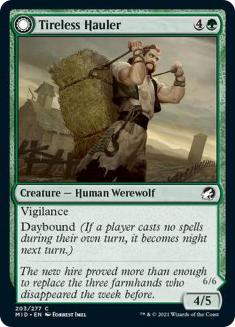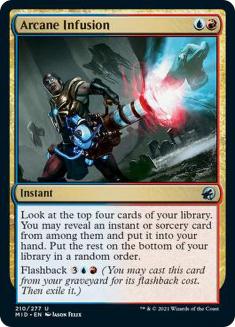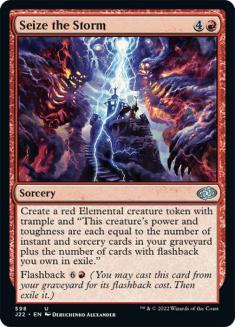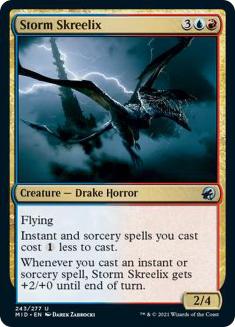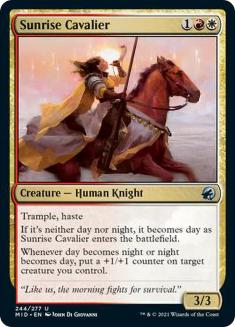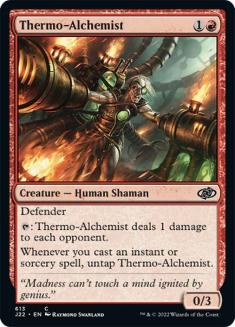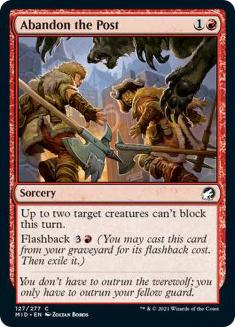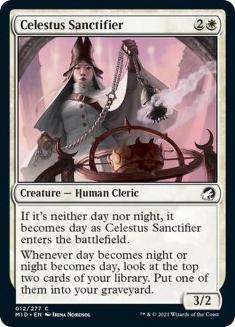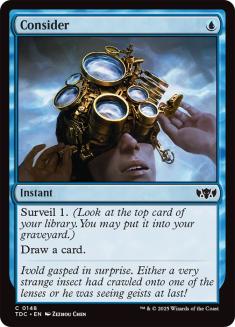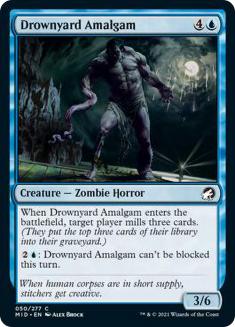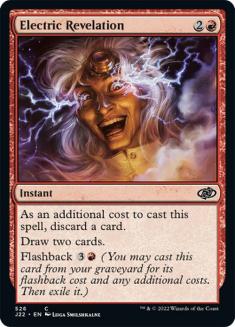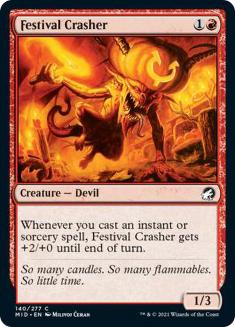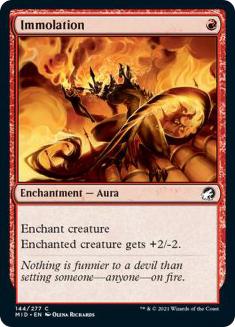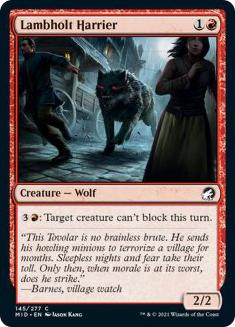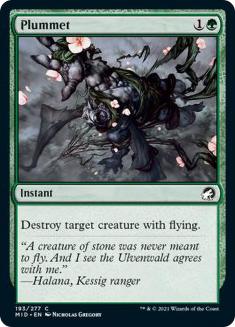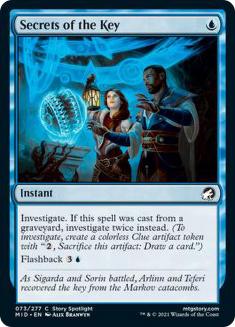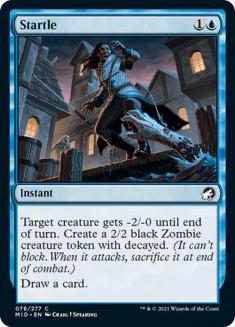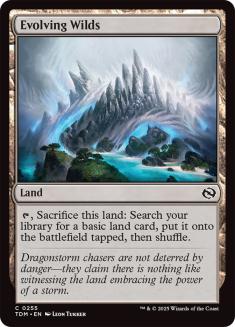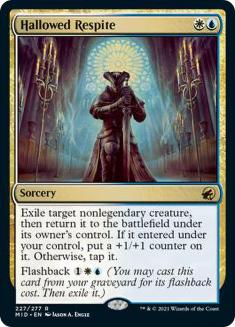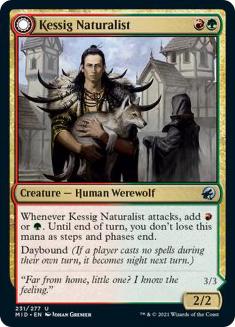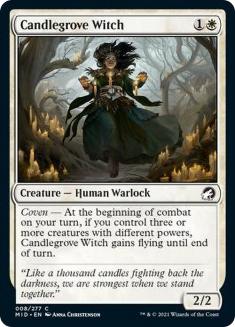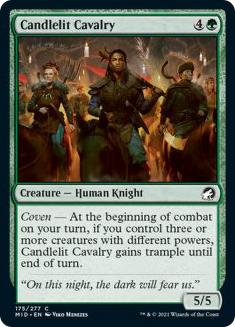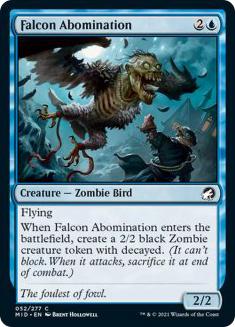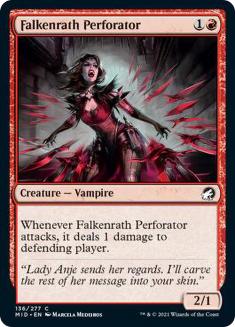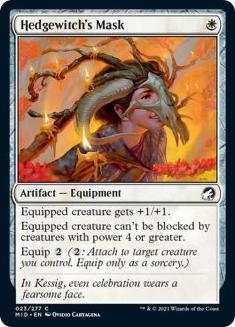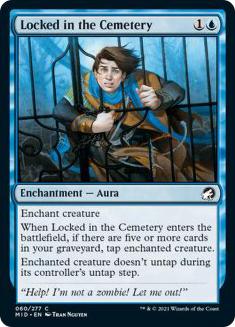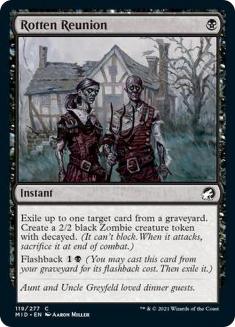I’m currently 40-11 with Izzet in Innistrad: Midnight Hunt Draft.
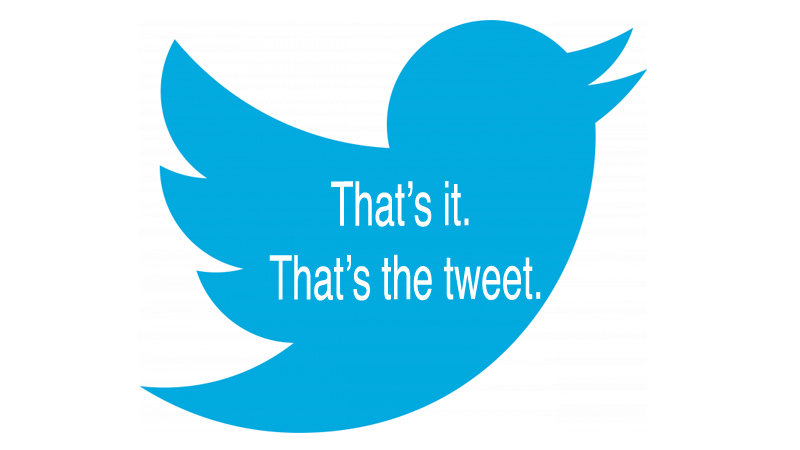
I know I wrote about the archetype last week in my article “How Do You Draft Red in Innistrad: Midnight Hunt Limited?” but I continue to hear other players and content creators hating on the archetype, so I wanted to write about it again. Let’s start by addressing the most common claim:
I have heard this statement (or something like it) from so many people, and I couldn’t disagree more. The reason I think this is happening is twofold:
1. Drafting preferences
2. Confirmation bias
It’s no secret that red is behind the other colors in terms of card quality. Many players have, arguably correctly, adjusted their priorities of red cards to reflect a preference of drafting all the other colors. The thing is, not all red cards are created equal. Festival Crasher, as an example, is a fantastic card in Izzet. If you’re open to drafting Izzet, even if you’re not open to drafting other red archetypes, you should treat Crasher as a top red common. Current preferences don’t lead people to take this card, or other red cards, highly. And, if you refuse to take the best commons for an Izzet deck, then of course you won’t end up drafting the archetype.
Related to confirmation bias, think about what the paragraph above means. It means that when reflecting on a draft, a player won’t see that Izzet was an option. If you don’t believe a good card for Izzet was an option at any point in the draft, then you won’t believe there was a good Izzet deck at the table. You’ll only believe that if all the Izzet cards wheel. But guess what? If the Izzet cards don’t wheel, that means that somebody is drafting the archetype.
I have drafted Izzet in over 40% of my drafts so far. Almost every deck I’ve drafted I’ve been happy with. I see drafters have a nearly mono-blue start and take a mediocre blue common over Seize the Storm at Pack 2, Pick 1. I then watch as the seat would have yielded a fantastic Izzet deck, but the drafter doesn’t even consider it as an option. I’m telling you to take a step back and re-evaluate. The deck is great, and it’s more open now as players are avoiding it.
So, What Makes a Good Izzet Deck?
Good cards.
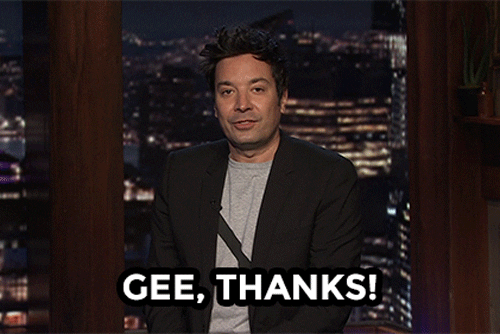
While this may seem like a pointless thing to say, I find it important because so many players view Izzet as a high-synergy deck focused on spells. Don’t get me wrong, I care quite a bit about the spell synergies, but I’m not looking to play bad spells or terrible rate creatures just because they fit the synergistic description of my deck. For example, Ardent Elementalist might look like a great spells card, but most of the other four-drops in this format are actually just better cards, which means most Izzet decks don’t have room for this card.
However, “good cards” in most blue decks, like Falcon Abomination, aren’t necessarily “good cards” in Izzet due to synergies. It’s a difficult balance and one that takes experience. So, what makes a card “good” in Izzet? It fits into one of the following five camps:
1. Defensive Speed
The way Izzet loses, particularly to Dimir, is falling too far behind to leverage the flexibility of options the spells provide. A key play pattern in Izzet is to pass the turn holding up multiple spells, and casting the best one at the end step. Turn 3 is a key part of this plan, because Moonrager’s Slash, Neonate’s Rush, Flip the Switch, and Electric Revelation are all spells I love to have in my Izzet decks. If you miss your two-drop, you’ll be forced to cast Flip the Switch or Moonrager’s Slash on the opponent’s three-drop. And if you’re on the draw and the opponent goes two-drop into three-drop, you’ll lose. Being able to decide to hold onto premium interaction like Moonrager’s Slash is key to success, and having cards like Festival Crasher and Baithook Angler are important to best leverage your spells in optimal sequence.
I think a lot of people think Festival Crasher is great for the deck because of explosive early kills. But it’s not. Explosive early kills happen, but they’re rare. Crasher is great because it helps you best sequence your spells, and blocks decayed Zombies late. It also gets in for damage, and turns the corner quickly, which is more valuable than trying to win by Turn 5.
2. Options on Options on Options
As I alluded to above, the best Izzet decks can hold up mana and have many different spells to cast. This makes the first copy of Secrets of the Key a premium card. Eleven mana is a lot to draw three cards, but Izzet is so good at holding up mana that it’s pretty easy to find spots to crack the Clues. Neonate’s Rush is currently one of the most underrated cards in the set for this reason. It may look clunky, because not every opponent will play a one-toughness creature. However, Izzet makes it such that you can then just cast a different spell. And if the opponent never provides a one-toughness creature, you can discard it to Electric Revelation. And, if you ever get to spend three mana to kill a creature and draw a card, that pulls you massively ahead.
3. Get Ahead, Stay Ahead
When I’m playing Izzet, I’m always looking for opportunities to put my opponent on the back foot. This is directly related to the options above. If I ever get to become the beatdown, and then pass the turn holding up card draw, removal, and a counter, it becomes extremely hard to lose. Revenge of the Drowned is one of the most important commons due to this. The extra damage from the Zombie can make the opponent have to play cautiously. If the opponent’s best play is a creature, they often are forced to put it on top, which is exactly what Izzet wants. It becomes a Time Walk variant, because they just cast it again, while Izzet continues to pull ahead, and then interact with it again. Even following up Revenge with a simple bounce spell like Geistwave can put the nail in the coffin.
Because of this play pattern, Stormrider Spirit can be a great late-pick common. Holding up interaction at five, and deciding, “Hey, I can actually assume the role of the beatdown if I cast this flyer instead of interact,” is a common play pattern. This also reinforces the importance of defensive speed. Given this plan, Izzet can struggle to pull back from behind, because the way the deck plays together is optimized when ahead.
Get the most out of your spells, but that’s a secondary priority to two-drops.
4. Threats: Win the Game
In order to have all these options in order to answer any situation and pull far ahead, a lot of spells are required. That’s the secret. The spells are less about maximizing synergies and more about facilitating a powerful gameplan. The fact that the creatures that care about spells can win the game on their own is what allows you to play fewer creatures, which makes room for a density of spells, which opens up the door for the gameplan while also maximizing your threats.
Spellrune Painter, Seize the Storm, Festival Crasher, Storm Skreelix, and Thermo-Alchemist are the classic ones at common and uncommon, but there are also quite a few rares as well as flyers like Stormrider Spirit or Delver of Secrets that can play the same role because flyers can go all the way, just a bit slower. The reason Delver and Stormrider are good, but Galedrifter is not, is the way it lines up with the gameplan. Spending four mana to tap out opens the door for the opponent to pull ahead. Delver is cheap, and can easily fit into the curve while still holding up interaction. Stormrider has flash, so you never have to put down your shields.
There are exceptions to this, but only for cards of obscenely high card quality, and Galedrifter does not fit in that camp.
5. High Card Quality
The last section is just about cards that are, well, too good. Think about Organ Hoarder. That card doesn’t really fit into any of the sections above, but it’s too good not to play. It can block and attack well, and it provides card advantage, selection, and graveyard synergies. I’m never cutting this card from an Izzet deck because it’s just that good.
Now that you understand the priorities about Izzet, let’s jump into a draft with a pretty interesting path. The start yields a strong bias towards Izzet, but that doesn’t mean Izzet is the only option. What would you take?
Pack 1, Pick 4
The Picks So Far:
The Pack:
The Pick:
I don’t know how many times I’ll have to say it, but Ardent Elementalist is not the type of card you want to have in your Izzet deck and it’s not the pick here. Now, I will say that having Light Up the Night does change this. I’m willing to play Elementalist alongside powerful spells like a Fireball variant, but I’m still not actively looking to pick one up.
Jack-o’-Lantern is currently a very underrated way of splashing, particularly alongside Organ Hoarder. Because of this, Light Up the Night can basically make any deck. While it gives me a bias towards Izzet, any blue deck can easily splash the card. This gives a unique texture to this pick.
Eccentric Farmer puts me on a path to draft Simic, which is the best deck for splashing Light Up the Night as well as having the most mana to leverage the nature of the Fireball. Lunar Frenzy is a game-ending top-end spell for Izzet that can also function as a nice combat trick, both offensive and defensive, alongside Festival Crasher. Having both Frenzy and Light Up the Night gives redundancy to the plan where burn gets pointed at the face. Shipwreck Sifters is the most flexible pick, as it’s fantastic in Azorius but playable in any blue deck given enough Spirits and cards with disturb. Additionally, it can discard Jack-o’-Lantern, which is a desired mechanism to splash Light Up the Night.
I took Eccentric Farmer. The reason for this is that, while any blue deck can splash Light Up the Night, Simic will be the most consistent at it. Additionally, Farmer is the card that makes Simic tick. If I end up Izzet, Shipwreck Sifters is unlikely to make my deck, and while Lunar Frenzy is good there, it’s not as good as Farmer is in Simic. This adds up to a close pick with a lot of options, but I believe Farmer is the best one.
Pack 1, Pick 5
The Picks So Far:
The Pack:
The Pick:
Winterthorn Blessing has been very impressive so far. If you have an early start, such as Unblinking Observer into Shadowbeast Sighting, then the Blessing can be used aggressively to put the game out of reach. If you’re behind, the Blessing can buy you multiple extra turns. And, in a tight game, it helps you turn the corner to swing the race in your favor out of nowhere. I wouldn’t fault anybody for taking the Blessing, particularly after taking Eccentric Farmer Pack 1, Pick 4.
However, I took Moonrager’s Slash. The reason I took the Slash is because if I draft Simic, I am 100% to splash Light Up the Night. Hence, Moonrager’s Slash should make my deck whether I draft Simic or Izzet. If I end up Simic, it’ll be worse than Winterthorn Blessing, but adjusting for the probability the card makes my deck yields the red removal spell as the correct pick.
Pack 3, Pick 2
Take some time to digest the pool of cards I have access to. I’m solidly Izzet now, but context is king. The pool has a pretty large influence on the correct pick out of the next pack.
The Picks So Far:
The Pack:
The Pick:
Vivisection has been bad more often than not. I know that decayed Zombie tokens make it look like Harmonize, but spending four mana to have a negative impact on the battlefield isn’t worth the card advantage. And that’s in Dimir. In Izzet, the card is almost always just atrocious. Even with some decayed Zombie tokens lying around, there aren’t enough of them and there aren’t enough creatures in the archetype to make this card worth considering.
Locked in the Cemetery might look like a solid removal spell, but it’s pretty mediocre outside of Simic. In an Izzet deck lacking interaction, it can be a necessity, but Izzet has quite a bit of interaction at common. If Cemetery isn’t turned on, the card is not good. Simic is great at doing that, Izzet is pretty good at it, but Izzet doesn’t have room for non-creature, non-instant, non-sorcery spells, which means the best Izzet decks never include Cemetery.
Falcon Abomination is a good creature, but not actually very good in Izzet. I think a lot of people are biased by the value of the decayed Zombie token in Dimir and the value of the flyer in Azorius. In Izzet, similar to Locked in the Cemetery, the best decks just don’t have room for the card. You can think of Falcon Abomination as filler in Izzet. You play it if you need a creature in that slot, but you hope not to need that.
It may seem odd that I’m offering this as an option alongside Strom Skreelix, a better Izzet threat, but sometimes you have to make a pick due to your curve. My deck already has top-end, and a third five-drop may not be a good option. While Abomination isn’t the pick here, there is a world where my pool is clogged at the top of the curve and I need more two- and three-mana threats. In that world, Abomination would be a real consideration.
This pick boils down to Storm Skreelix and Consider. Skreelix is a card I like quite a bit for Izzet, as it’s a great blocker and can end a game all by itself. In Pack 1, I’m likely to take this card to position myself into Izzet over a flexible and cheap spell like Consider. However, if you consider what’s in my pool, I have a good amount of top-end threats. I already have a Skreelix and a Seize the Storm. Taking a cheap instant to make all my spells-matters cards better is a better pick than another top-end threat. Additionally, if Izzet is incredibly open, the Skreelix has a chance to wheel.

